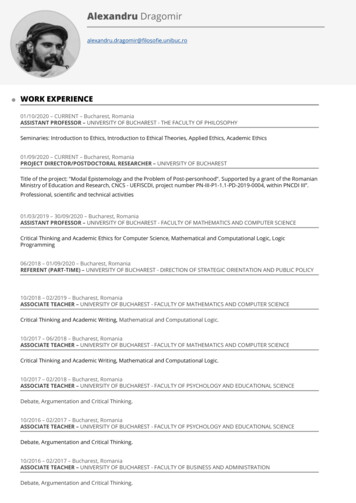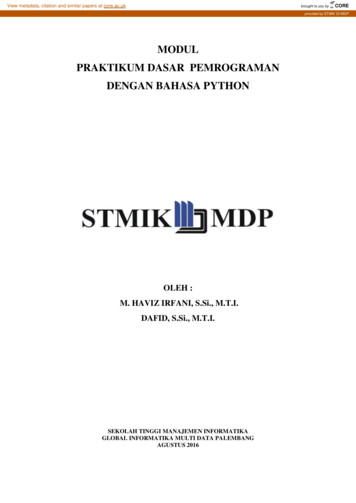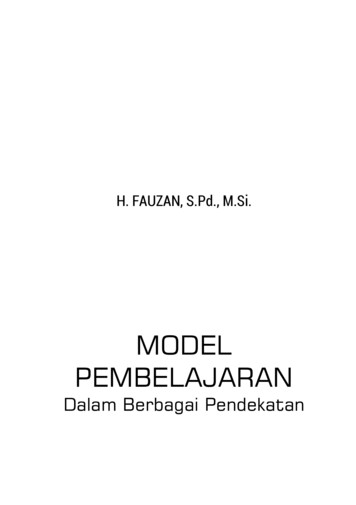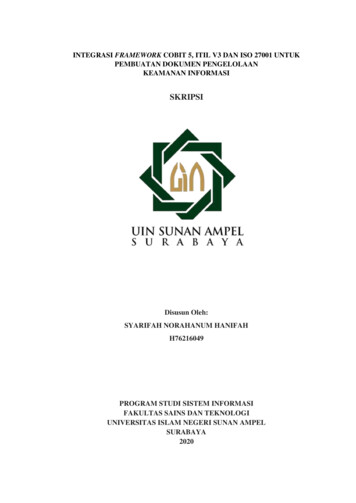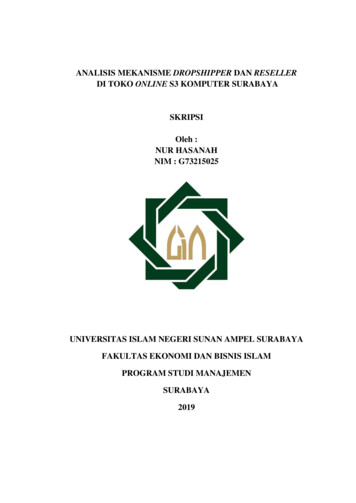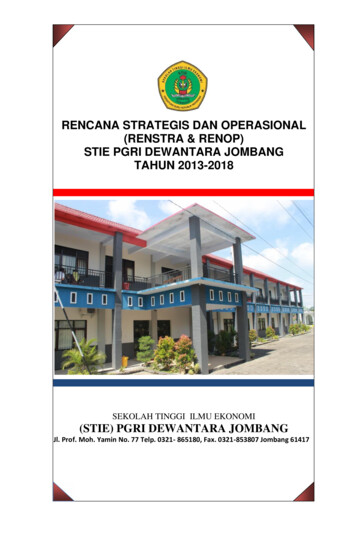
Transcription
DAN VALERIU VOINEAALEXANDRU STRUNGĂ(EDITORS)RESEARCH TERMINALSIN THE SOCIAL SCIENCES
DAN VALERIU VOINEA ALEXANDRU STRUNGĂ(EDITORS)RESEARCH TERMINALSIN THE SOCIAL SCIENCES[The Proceedings of CIL 2020: Ninth Edition of InternationalConference of Humanities and Social Sciences - Creativity,Imaginary, Language,Craiova, Romania, 22-23 May 2020(www.cilconference.ro)]SITECH Publishing HouseCraiova, 2020
Corectura aparţine editorilor. 2020 Editura SITECHToate drepturile asupra acestei ediții sunt rezervate autorului. Orice reproducere integrală sau parţială, prin orice procedeu, a unor pagini din această lucrare, efectuate fără autorizația autorului este ilicită și constituie o contrafacere. Sunt acceptate reproduceri strict rezervate utilizării sau citării justificate de interes științific, cu specificarea respectivei citări. 2020 SITECH Publishing HouseAll rights reserved. This book is protected by copyright. No part of this bookmay be reproduced, stored in a retrieval system, or transmitted in any formor by any means, electronic, photocopying, recording or otherwise, withoutwritten permision from the copyright owner.Editura SITECH face parte din lista editurilor românești acreditate deCNCSIS și de asemenea face parte din lista editurilor cu prestigiulrecunoscut de CNCS, prin CNATDCU, pentru Panelul 4.Editura SITECH Craiova, RomâniaAleea Teatrului, nr. 2, Bloc T1, parterTel/fax: 0251/414003E-mail: office@sitech.ro / editurasitech@yahoo.comISBN 978-606-11-7565-9
TABLE OF CONTENTSI. COMMUNICATION & JOURNALISM . 7Empathy and active listening in the humanistic social work . 9Simona RodatGender rights equality in the media . 26Alexandra IorgulescuWays to improve corporate communication performance . 30Mihaela MarcuInterrogation as a type of communicative behaviour in the digitalenvironment . 35Xenia NegreaTransitions and concepts within decentralized finance (defi) space . 40Andrei-Dragoș PopescuThe message as an exam . 62Ștefan VlăduțescuFacilitating access to cultural heritage through cultural mediation andtourism. Case study: european capital of culture timișoara 2021 . 71Codruța-Diana Simionescu, Ilie RădoiApproaches to communication management in a doctor - patient relationship 84Ana-Maria PredilăCritical thinking tests used in personnel recruitment and selection . 90Cătălin-Lucian Cioclei“Residual communism”: between media speculation and academicdebate . 98Vlad Ovidiu CioacăThe importance and role of the journalist during Covid-19. Lessons learndfrom home journalism . 105Georgiana Stănescu5
Considerations on editing and delivering radio news content . 115Davian VladEditorial diversity and standardized information in the local mass media 121Maria CrăciunHow media literacy can help filter information from disinformationattacks . 127Dan Valeriu VoineaA look at intercultural communication . 136Ștefan VlăduțescuI. EDUCATION SCIENCES. 141The relationship between experiential learning and the progress in preschoollearning in preschool learning. 143Aida StoianInside-T project: premises for an intergenerational education curriculummodel. 153Alexandru StrungăPostmodernist orientations and perspectives in history teaching . 159Felicia Elena Tatu (Boșcodeală)Managementul ciclului proiectelor de parteneriat educațional . 170Mihaela-Alexandra ȘtefanTraining management in early education from the perspective of virtuallearning communities . 179Claudia Irina Aldea6
I. COMMUNICATION & JOURNALISM
EMPATHY AND ACTIVE LISTENINGIN THE HUMANISTIC SOCIAL WORKSimona RODATProfessor, PhD,Adventus University, Faculty of Theology and Social Sciences,Cernica, Ilfov, RomaniaEmail address: simona.rodat@uadventus.roAbstractThe present paper deals with the role of empathy and active listening insocial work, focusing mainly on the humanistic theoretical models,according to which active listening is a form of operationalization ofempathy. Empathy is the human specific ability to psychologically transposethe self into the psychology of the other, through a phenomenon of resonanceand emotional communication. Listening plays an important role in thisprocess and generally in communication between people. Especially theactive listening maintains the communication relations and contributes tomitigating conflicts in different social contexts. Moreover, empathy makesus more understanding, because placing ourselves in the position of theinterlocutor limits our tendency to judge his behaviour without nuance.Active listening means that the receiver of communication actively assumesthis role, by expressly following the understanding of the transmitted message,manifestly showing his mindfulness, and immediately and explicitly offering theaccording feedback. In activities where communication and comprehension areessential, as is the case with social work, active listeningis the most desirableform of response in the interaction between interlocutors. Besides outliningthese aspects regarding empathy and active listening, especially from ahumanistic perspective, in the paperthe features and the main techniques ofactive listening used in social work are also delineated, explained andexemplified.Keywords: empathy, active listening, humanistic social work, techniques ofactive listening in social work9
IntroductionEmpathy and active listening are fundamental concepts in manymodels of social work. They play a central role, especially in the practicalmodels inspired by the humanist current, and particularlyin client-orientedapproaches.Empathy is the human specific ability to psychologically transposethe self into the psychology of the other, that is, the imaginative enteringofone individual in the thinking, experiencing, acting of another, through a“phenomenon of resonance, of affective communication” (Marcus 1997,11).In interacting with others, empathy makes us more understanding,because placing ourselves in the position of the interlocutor limits ourtendency to judge his or herbehaviour without nuance and urges us to grantmitigating circumstances even to the facts and attitudes that shock us at firstsight (Dinu 2004, 44).In the humanistic theoretical and practical models, empathy findsitsoperationalization through active listening. This is a type of listening thatinvolves a form of activism on the part of the receiver, which means anexpress pursuance of the full decoding of the received message, as well asgiving an eloquent feedback in this regard. Active listening contributes tomaintaining thecommunication relations and to mitigating conflicts indifferent social contexts.The present paper addresses the role of empathy and active listening insocial work, focusing mainly on the humanistic theoretical models, especially onthe person-centered approach as developed by Carl R. Rogers (1951). Afterhighlighting the place of listening in communication, as well as its forms andfunctions, the term of active listening is outlined, including the verbal and nonverbal messages that signalise or emphasizethat somebody actively listens.Further, the client-centered or client-oriented approach is addressed, the mainviews of this perspective being highlighted, and the techniques of active listeningused in thehumanisticsocial workbeing delineated, explained and exemplified.Listening – functions and phasesIn communication, listening plays a fundamental role. According to M.Dinu (2000, 33), in a sequence of communication, more than half is listening.More precisely, 53% of the total communication sequence is listening, whileonly 16% is speech, 17% is read and 14% is written.Listening fulfils several10
functions in communication (Watson and Hill 1993, 104): a) control ofunderstanding; b) encouraging communication – any receiver must havefeedback in the communication; at the transmitter’s level the reaction of thereceiver is as important as the message transmitted; c) ensuring the correctfeedback.But not all the receptive behaviours that refer to or involve listeningare similar. Such behaviours can be ranged on a continuum from simplehearing to active listening. The latter presumes that the receiver is active, heor she expressly following the full decoding of the received message andproviding an eloquent feedback in that respect.There are three distinct types of receptive behaviours that are similarand refer to or involve listening: a) “non-listening” – refers to a situation inwhich someone assumes the receiver status without actually listening; b)“listening”; c) “meditation” (or thinking) (Ştefănescu 2009, 57). Listeninghas its own internal gradations, being in fact a continuum that varies fromnon-listening to the level of thinking – in which case reflexivity also appears(Marinescu 2003, 39). Therefore, listening pursues the following phases:a) hearing – the automatic act of receiving and transmitting to the brainof the sound waves generated by the emitter’s speech; expresses thephysiological impact that sound waves produce;b) understanding – the act of identifying the communicated informativecontent, recomposing the sounds heard into words, and words insentences and phrases;c) translation into meanings – involves the memory, and linguistic,cultural, and speaking experience of the listener;d) assignment of meanings to the information received – it is performedaccording to the level of operationalization of the language,vocabulary, linguistic performances;e) evaluation – making value judgments or adopting value attitudes bythe listener.Active listeningActive listening is the form of listening that, in communication,provides the mostsignificant gratification to the speaker. Moreover, itcontributes to keeping the communication relations, informs about theexpectations of other individuals, and can mitigate and stop many of thesocial conflicts. But although active listening is the most fulfilling form of11
listening, it is not present in all communication contexts. In fact, in manysocial situations active listening is absent.This type of listening means that the subject actively take part in theprocess of listening, being fully concentrated on what is being said, not justpassively hearing the message of the speaker. In active listening not only thelistener gives full attention to the speaker, but also he or she must be seen tobe listening. The interest can be conveyed to the speaker by using bothverbal and non-verbal messages or signs.Among the most prevalentverbal messages or signs of active listeningthe following are included:Positive reinforcement, by using words or phrases such as “indeed”,“very good”, “yes” etc. The best positive reinforcement is when the listenerelaborates or explains why he/she is agreeing with a certain point transmittedby the speaker.Asking questions, which means asking relevant questions or/andmaking statements that build or help to clarify what the speaker has said. Byasking questions the listener reinforces that he/she is interested in what thespeaker has been saying.Remembering key points, names, details, ideas and concepts fromprevious conversations helps also to reinforce that the attention of thelistener has been kept and that the messages sent by the speaker have beenreceived and understood.Reflection, by repeating and paraphrasing what the speaker has said,is a powerful skill that demonstrates attention and understanding and showsthe comprehension of the listener.Clarification, by using open questions which enable the speaker toexplain or expand on certain points, shows that the listener ensures thathe/she received the correct message or meaning.Summarisation, by repeating, usually with own words of the listener, asummary of what has been said, back to the speaker. Such a feedback, throughthe reiteration of the message in a summarized, clear and logical way, not onlydemonstrates attention and understanding, but also gives the speaker the chanceto correct some points of his/her message, whenever necessary.There are also non-verbal messages or signs of active listening, whichinvolve:Eye contact, which can show the speaker that the listener payattention; anyway, too much eye contact can be intimidating, especially for12
more shy speakers, that is why the eye contact should not be too long andshould be combined with other non-verbal signs of listening.Smile can be also used to show that the listener is paying attention;combined with nods of the head, smiles can be used as signs that themessage is listened and understood.Posture is another important way to communicate feedback ininterpersonal interactions. An attentive posture may include that the body isleaned slightly forwards or sideways while sitting, or the head is a bit tiltedor is resting on one hand.Mirroring or automatic reflection of facial expressions is also a signof attentive listening, helping to show empathy or sympathy in moreemotional situations.Showing no signs of distraction: while active listening, someonemanifests no tokens of distraction such as fidgeting, looking at the clock orthe watch, doodling, playing with the hair or picking the fingernails.The above-mentioned non-verbal signs are more likely to bedisplayed by those who actively listen. However, some signs may not beappropriate in all situations and across all cultures (SkillsYouNeed 2019).Active listening has a number of qualities which include (Şoitu 2001,160-163):a) Informs about a particular person and aboutthe expectations ofother individuals in relation to that person. The type of “Self” closed or opendepends on the ability to listen actively.b) Contributes to the upkeeping of the communication relations thatare established with important persons from the point of view of theindividual involved in the communication.c) Can mitigate or even stop social conflicts, because nine out of tenconflicts are or can be solved through communication.Active and empathiclistening in the humanistic models of social workThe philosophical current of humanism has exerted an importantinfluence on the theoretical developments in sociology, psychology, and alsoin social work. The theories and models of practice in social work based onhumanist views focus on the idea that human beings are trying to make senseof the surrounding environment and to understand the world they areexperiencing. Humanist models take into consideration the fact that people’s13
self-interpretations, as well as the interpretations they give to the socialworld, are valid and valuable. Therefore, social workers should help peopleacquire skills to analyse themselves and to explore the personal significationsthey give to the perceived world, and which affect them (Payne 2011, 208).The client-centered or client-oriented approach is an importanthumanistic direction of operation in social work, initially used incounselling, but also in working with families and small groups. Thisapproach is based on the idea that each client should be treated as a uniqueindividual (Rogers, 1951), and social work should focus on the persons andtheir subjective experience (Wilkes, 1981; Goldstein, 1984; England, 1986).Client-centered therapy implies a way of being with persons thatpromotes curative change and development. The central hypothesis of thisapproach is that the person has extensive resources in himself/ herself forunderstanding himself/ herself and constructively changing his/herbehaviourand way of life (Rogers 1991, 187).In this perspective, the social worker’s approach should be nondirective, tolerant, involving “active listening”, “pure empathy” and“genuine friendship” (Rodat 2016, 146). Humanistic therapy in social workshould be based on discussions (Howe 2001, 76), because people, whereverthey are, are looking for other people to listen to their problems, and to sharetheir problems. But beyond listening, human beings must also feel warmth,love, understanding and empathy. In this vision, there is nothing intellectualor complicated in helping others; the basis is, in fact, simple: help is done outof love and goodwill.In client-centered humanistic social work, social workers musttherefore demonstrate:1) honesty and authenticity;2) warmth, respect and acceptance;3) empathic understanding by the therapist;4) unconditional positive regard of the therapist.Empirical data confirm that these are the essential elements in aneffective therapeutic relationship.The key concept in Rogers’ approach is “empathic understanding”(Katsivelaris 2012, 7). In order that his/her “inner framework” to beperceived “as precisely as possible”by professional helpers,the client shouldbe nudged, with the aim of good “guidance”, to talk about himself/herself.To be empathic means to perceive the inner frame of reference of the14
other as preciselyas possible. The inner frameworkis the subjective world ofthe individual (Rogers 1987, 37).Empathy as a technique of “guidance”also includes, by adopting aprofessional role, “to enterthe private world of perception of theother and tobecome completely at home in it” (Katsivelaris 2012, 7).Empathy means“temporarily living the person’s life; moving cautiously in it withoutmaking hasty judgments”(Rogers 1980, 79). It includes that onecommunicatesabout one’s/his/her own feelingsconcerning the world of thatperson, because one lookswith fresh and fearless eyes at things, that theotherfears/ is afraid of.To deal with another person in this way means toleave one’s own views and values aside in order to enter the world of theother without prejudice(ibid.).Empathy is the specifically human ability to psychologically transfer theego into the psychology of the other, i.e. the imaginative entrance of oneindividual into the thinking, experiencing and acting of anotherindividual,through a phenomenon of resonance and emotional communication (Marcus1997). By placing ourselves in the inner world of another, or “getting underanother person’s skin”, that is, being more empathetic, we become also moreinsightful and morekind, because this positioninglimits our tendency tojudgeundifferentiated the attitudes and behaviours of othersand induce ustomitigate the facts and points of viewthat shock us at first glance (Dinu 2004).In Carl R. Rogers’ view, empathyfinds a concrete and observableoperationalization in the form ofactive listening, as a technique ofinterviewing.The goal of person-centered or client-centered therapy, thegoal of its techniques of conversation, especially through active listening, asoperationalization of empathy, is thus the optimization of the person –his/her best possible “guidance”– throughempathy.Using the concept ofempathy as understood by Rogers means, therefore, for social work, that thepurpose of professional guidance through empathy is represented by certainchanges in behaviour, in exchange for participation (Scherr 2004, 96).Active listening should be carried out in social work with thegreatest possible degree of neutrality and value-freedomand at the sametime it should be appreciative towards the client, so thatto keep open allunderstanding ways of the overall message.Otherwise, the social workersrunthe risk of not being able to perceive and gather everything that isrelevant to the person involved, as a result of the individual filter that comesinto play. This often leads to the fact that the person concerned – justifiably– does not feel sufficiently “understood” or heard.15
Following Rogers’ general ideas, other more recent authors (Wilkes,1981; Goldstein, 1984; England, 1986) have developed client-centeredapproaches. The works of these authors have in common the orientation towardsthe person and the subjective experience. They use terms such as: personcentered, empathy, intuition, love, respect, sharing feelings. According to theseauthors, the only effective way to learn is experiential. In the spirit of this schoolof thought and practice, a good social worker is a creative person, and socialwork is an art (Howe 2001, 82).Therapy, counselling or any other form of socialwork can be reduced, in this perspective, to discussions (ibid., 76). People,wherever they are, are looking for other people to listen to their troubles, toshare their problems. But beyond listening, they must also feel warmth, love,understanding, empathy and compassion.Communication is a basic element of humanistic practice.It involvesmutual activity, including reception and feedback. If communication isgood, it leads to mutual understanding.Techniques of active listeningIn social work, what the client says must be appreciated and evaluated sothat all relevant information is retained. Through active listening, the person inquestion must receive signals that he or she is sufficiently listened to andunderstood (Clausner-Landerer, 2005). That is why, when active listening ispracticed, a number of techniques can be used (see also Șoitu 2001, 165),among which the most commonly used and effective are:1) Paraphrasing the speaker– meansthat the listener reformulates thereceived message in his or her own words.It implies that, after receivingsufficient information, the listener re-communicates the message in his/her ownwords, in order to establish real points of communication with the interlocutor.This technique enables the social worker to check whether he/she,inthe context of “active listening”, has correctly heard, and secondly –provided thatthere is congruence – itgives the other person the feeling thathe/she has been correctly understood/ heard. Ultimately, this conversationtechnique also has,to a certain extent,a structuring character, when itcondenses what is listened. Ongoing paraphrasing also ensures that thoseinvolved in the counselling session do not lose contact with each other, butactually remain facingeach other.Paraphrasing ensures a high degree ofunderstanding in communication.16
Example (Manual de bunepractici în asistenţa socială comunitară, 35):“The client – Recently I get home late and I can’t talk enough withmy husband and my children.The social worker –If I understand you correctly,you have a busyschedule at work that does not allow you to take care of your family the wayyou want .”.Paraphrasing can also help to clarify some issues and aspects, and toincrease the accuracy of what is communicated. As the practice reveals, often thestatements of the assisted persons do not match what they have said before oreven contradict their previous stories or confessions. By paraphrasing, thesestatements can be revisited,and the client can be given the opportunity to corrector clarify inconsistent or contradictory messages and reports.In this way,inconsistencies and contradictions are discovered and clarified promptly, and notonly later, when it is possible that they have already influenced the generalapproach of intervention. Therefore, the social worker must addressinconsistencies as soon as possible after their appearance, with determination, butat the same time with diplomacy, without judging or criticizing the client forcontradictions, as in the following examples (Clausner-Landerer 2005, 5):“Earlier you told me that. But now you say it was. I see acontradiction in this regard, can you clarify this .?”.“At the first meeting you said that you were not interested in theproblem, but now you think that. and, at the same time, I notice a lot ofanger in your voice; maybe it would be useful to talk again about. It wouldalso help to tell me what makes you so angry.”.2) Verbalization– is, along with paraphrasing, another technique ofactive listening, especially useful when it is necessary to assign an appropriatelevel of abstraction toclient’sstatements. Through this technique, the ideas orexperiences of the client are expressed or formulated through the appropriatewords and phrases, as only implicitly emerges from his or her stories. Example:“The client – Anyway, there is no point in talking to him, I’m fed up.He doesn’t even understand how I feel.Thesocial worker – Youdoubt that a discussion with your husbandwould bring any progress in terms of. I understand that previousexperiences in this regard leave you in doubt about the usefulness of adiscussion. However, it would be important for you to present your point ofview and your feelings, if you have the opportunity”.17
3) Asking questions– isa necessary technique to discover the subtextand to understand exactly what the speaker wants to communicate (Şoitu2001, 165). Active listening involves the investigative effort of the listener.This does not mean that the receiver has to often interrupt the interlocutor toask questions, because that would fragment the communication and disturbthe transmitter, who may thus lose the track of ideas. That is why it isrecommended that the communication partner should be allowed to presentall his/her ideas, and only after that the questions should be asked.Depending on the nature of the clarifications or additionalinformation that the social worker wants to obtain, the questions can be ofvarious types:a) Open questions– arethe most frequently asked questions,used forfactual issues and for obtaining information that could be relevant forunderstanding the situation of the client and for establishing the approach ofthe intervention.In this case, open questions, which involve narrativeanswers, are preferable, because in this way the person’s overall situationcan be understood, and/or his/her problem can be placed in a broadercontext. Example:“The client – WhenI think of Wednesday last week, I see black infront of my eyes.The social worker – Whatexactly happened last Wednesday?Or –Please, tell me more about it”.Other examples (Clausner-Landerer, 2005: 3):“What exactly happened when. / at.?”“Please describe exactly the situation/ state of affairs from your pointof view.”“Tell me more about.”“Explain to me what you did. / what happened.”“What concrete/ specific expectations do you have from me/ from thesocial work department/ from the organization.?”“How do you represent my/our help.?”b) Closed questions– areparticularly useful when it comes to finalclarification of the facts and corrections regarding the understanding of thesituation. In this case, the interrogation process is less narrative and usuallyfocuses on receiving specific information.Example:“The client – I’m afraid of the radical changes after the divorce.18
The social worker – Wouldyou like to discuss with our consultantinthis regard?Or – Wouldyou like to consult the lawyer of our organization in thisregard?”.Other examples:“Did you take part in the discussion from. / between.?”“Were you present at the meeting. / when did it happen.?”“Do you want to consult with X about.?”.c) Exploratory and diagnostic questions– are the questions that havecertain structuring elements and initiate a change of perspective of theexplanations. Theyare suitable to bring the person who explains out ofhis/her own thinking process and to a certain extent integratehim/her in thethinking process of the social worker. Such questions aresubdividedaccording to emotions, causes and motivations for events and actions, as wellas according to past, present and future. Examples:“How did you feel in that situation and how did the others react.?”“What do you think, why did X behave like this.?”“How did you react to this. / when.?”“What do you want to achieve in the future in terms of.?”.d) Confrontational questions– are also divided by emotions, causesand reasons, as well as by past, present and future. Through this type ofquestion, the assisted person, especially when he or she asks for advice, isput in the situationto face the ideas, concepts, hypotheses, assumptions andoptions of the social worker and to deal with them. Examples:“When you behaved like that. / you made the decision., did youthink it would lead to/ did you think about the consequences for .?”“Have you thought that your behavior can have these repercussions/effects.?”“Don’t you think youoverestimate the situation.?”“Do you think that in the future you could do/ not do. to change.?”“Could you do/ not do to avoid escalation.?”.e) Circular questions– areused especially in systemic interviewtechniques and are particularly useful when looking forinformation aboutrelationships between people and their different perceptions of facts. Suchquestions often focus on hypothetical events and behaviors. Examples:“What options would you have if you don’t accept X’s proposal andhow would it evolve.?”19
“How would your husband behave if.?”“How would your boss and colleagues react if you had / if youwould do. in the future?”“We have been talking for a long time without reaching a solution,please think about what we could do tobetter understand each other”.f) Strategic questions–have mainly a guiding intention. This type ofquestioning technique allows the social worker to influence the subsequentdevelopmentof the relationship with the client. Strategic questio
In communication, listening plays a fundamental role. According to M. Dinu (2000, 33), in a sequence of communication, more than half is listening. More precisely, 53% of the total communication sequence is listening, while only 16% is speech, 17% is read and 14% is written.Listening fulfils several

